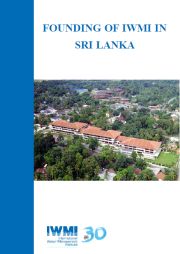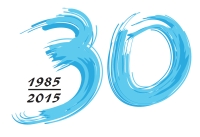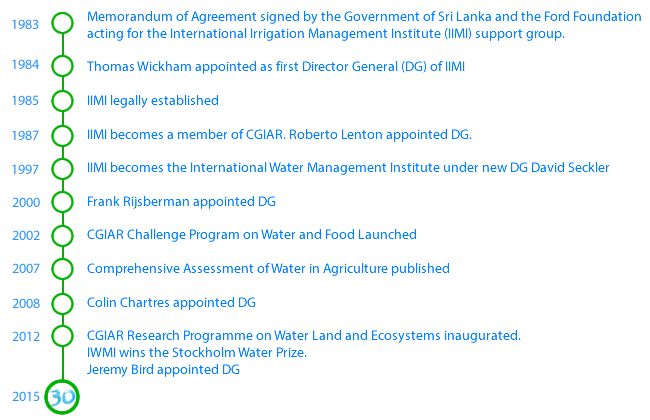Our history
A brief history of IWMI
Timeline
How it all began

The launch of the International Water Management Institute in 1984 was the culmination of a process set in motion by two significant events that took place as far back as 1969. One was a proposal to the Bellagio Group – an international group of experts and donors – stressing the importance of water management in agriculture. The second was a joint proposal by the Ford and Rockefeller Foundations to carry out multidisciplinary research on irrigation technologies, the economics of water management at national and farmer levels, and water policy issues at national and international level.
The need for research was evident as issues of water management continued to surface through the 1970s at Technical Advisory Committee (TAC) meetings of the US-based CGIAR. Established in 1971, CGIAR is a strategic partnership of countries, international and regional organizations, and private foundations. It currently supports the work of 15 international research centers.
By 1979, water management was one of TAC’s key recommendations to the Bellagio Group for future research funding. Eventually, through the efforts of a CGIAR-appointed team that visited numerous countries and irrigation projects in 1982, recommendations were made by TAC for the establishment of the International Irrigation Management Institute (IIMI), funded by CGIAR.
CGIAR was reluctant at that time to add to the number of centers already funded by them as the numbers had already increased from 5 to 13 centers between 1969 and 1982. However, CGIAR promoted the establishment of IIMI without formal sponsorship by them. Interested CGIAR members asked the Ford Foundation to act as the implementing agency to establish IIMI. Ford sent a team to India, Sri Lanka, Pakistan and the Philippines to determine how interested those countries were in hosting the Institute.
Sri Lanka – the host country
There was strong support for the IIMI proposal from all four countries. The IIMI Support Group that evolved for the purpose of establishing the Institute authorized the Ford Foundation to enter into negotiations with the Government of Sri Lanka, and plans were made to select a Board of Governors and identify candidates for the position of Director General. The World Bank was also confirmed as interim custodian of funds contributed by the Support Group with the total budget requirements for IIMI’s first 5 years estimated at USD 12 million. The choice of Sri Lanka appears to have been more than just a coincidence. Sri Lanka is a country with a long history of irrigation management, first carried out by its ancient kings and seen in the numerous man-made reservoirs, anicuts and other irrigation structures built across the island. On September 1, 1983, a Memorandum of Understanding (MOU) was signed by the Government of Sri Lanka and the Ford Foundation acting on behalf of the Support Group. Shortly afterwards, the first Board Meeting was held in Colombo and Ralph W. Cummings was appointed Acting Director General with the responsibility to establish the Institute in Sri Lanka and in other countries where IIMI might have cooperating and participating units.
The launch of IIMI
The Charter was ratified on May 31, 1984, by executive action through the Ministry of Foreign Affairs. On June 15 of the same year, Dr. Thomas Wickham was appointed Director General and IIMI began formal operations. The headquarters of IIMI were established at the Digana Village, 14 kilometers east of Kandy, in the central highlands. On November 30, 1984, the Parliament of Sri Lanka enacted legislation to formally establish IIMI as a corporate body, international in character with legal status, privileges and immunities. This legislation enabled the implementing agency to relinquish its role, and on January 1, 1985, IIMI’s Board of Governors and staff assumed full responsibility for the Institute and its operations. IIMI’s initial mandate was to improve irrigation system management. Much of the Institute’s work involved a large technical assistance component and research was sometimes only a by-product of that work. Under the leadership of Dr. Wickham, IIMI established projects and placed staff in five countries, namely Sri Lanka, Pakistan, Indonesia, Nepal and the Philippines. The Institute also laid the basis for expansion into more countries.
IIMI becomes a CGIAR center
In 1991, IIMI became a member of CGIAR and the first External Program and Management Review (EPMR) carried out in 1994 recommended a shift to more strategic research, seeing the potential of the Institute’s work. Dr. Roberto Lenton was the Director General of IIMI at that time. The EPMR recognized IIMI’s impact on national irrigation policy in the two countries where it had its largest and longest established programs: Pakistan and Sri Lanka. Irrigation Management Transfer (IMT) and Participatory Irrigation Management (PIM) were also high on IIMI’s research agenda under its theme of Water Resources, Institutions and Policies. In Pakistan, IIMI’s pioneering research on the problem of salinization led to action at the highest levels of government. By this time, IIMI was also working in India and Africa – particularly West Africa.
The year 1991 also marked the relocation of IIMI Headquarters from the Digana Village in Kandy to Battaramulla, which lies on the outskirts of Colombo, the commercial capital of Sri Lanka. IIMI’s new office building was located in a picturesque setting close to the country’s parliament. The building was a gift to the Institute from its host country, with the generous assistance of the Governments of Canada and Switzerland, and the Ford Foundation.
IWMI: The new name and paradigm
In 1996-2000, under the leadership of Dr. David Seckler, who was the Director General at that time, IIMI transformed itself into a “strong science-based organization concerned with the more effective and productive use of water as a key resource for improved food production.” This saw the birth of the “More Crop per Drop” concept. The Institute also changed its name from the “International Irrigation Management Institute” (IIMI) to the “International Water Management Institute” (IWMI) with a new mandate to “contribute to food security and poverty eradication by fostering the sustainable increases in the productivity of water through the management of irrigation and other water uses in the river basin.” The research programs began to address water management and irrigation issues at the basin scale with a focus on regional water scarcity.
Beyond “more crop per drop”
While “More crop per drop” focused on water productivity, IWMI began to increasingly view it as inadequate and this was expressed in the 2004 to 2008 Strategic Plan. The Institute’s mandate did not cover issues of multiple uses of water beyond crop production. Under the leadership of Prof. Frank Rijsberman, who was IWMI’s Director General from 2000 to 2007, the Institute expanded its mission to “Improve the management of water and land resources for food, livelihoods and nature.” This was supported by IWMI’s merger with the International Board for Soil Research and Management (IBSRAM) in 2001. The Institute also refined its research agenda to incorporate four themes covering basin water management, land, water and livelihoods, agriculture, water and cities, and water management and the environment. IWMI built up strategic alliances with national and international partners and CGIAR centers, and aimed to become a world-class knowledge center for water, food and the environment through knowledge generation, dissemination, brokering and application. At the same time, business systems were re-engineered and administrative processes streamlined through quality management procedures. An organizational culture of impact, performance and service was established.
Dr. Colin Chartres, an Australian scientist with over 30 years’ experience in water and land management, was appointed as Director General in October 2007. Under his tenure, IWMI strengthened its global presence, culminating in the award of the Stockholm Water Prize in 2012.
In 2012, IWMI launched the CGIAR Research Program on Water, Land and Ecosystems in early 2012.
In October 2012, Jeremy Bird, formerly CEO of the Mekong River Commission, was appointed as Director General.
He was succeeded in October 2017 by Dr. Claudia W. Sadoff.
Three decades of achievement
 In 2015, IWMI celebrated thirty years of delivering research excellence. During those three decades new ways of collecting, distributing and managing water have continually influenced our scientists’ work. Technological advances in satellite imaging, computer modelling and data analysis are transforming our cross disciplinary studies, delivering cutting edge solutions to some of the world’s most pressing challenges.
In 2015, IWMI celebrated thirty years of delivering research excellence. During those three decades new ways of collecting, distributing and managing water have continually influenced our scientists’ work. Technological advances in satellite imaging, computer modelling and data analysis are transforming our cross disciplinary studies, delivering cutting edge solutions to some of the world’s most pressing challenges.
Underpinning our approach is a continuing commitment to poverty alleviation, social inclusion and sustainable natural resource management. Recognized as a world leader in water management science, IWMI’s unique experience enables it to contribute to the success of the United Nations’ Sustainable Development Goals.
Today, IWMI has an expanded mandate , concentrating on water and related land management challenges that poor communities face. IWMI works through collaborative research with many partners in the Global North and South and targets policy makers, development agencies, individual farmers and private sector organizations.
IWMI also enjoys greater national and international visibility. It is a modern, robust institute that has adapted to the needs of the 21st century through organizational transformation.


